Bathroom Readers' Institute's Blog, page 126
October 28, 2014
They Did ‘The Monster Mash’
And it was, by all accounts, a graveyard smash. Here is the story of The Original Monster Mash.
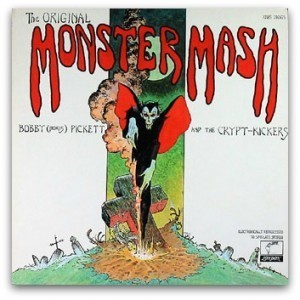 To bide his time until he landed a successful audition, actor Bobby Pickett fronted a Los Angeles cover band called the Cordials. Goofing around one summer night in 1962, he performed “Little Darlin’” in the spooky, monster-movie voice of Boris Karloff. It went over well, as America was in something of a monster movie revival period, with Karloff’s old horror films airing often on late night TV.
To bide his time until he landed a successful audition, actor Bobby Pickett fronted a Los Angeles cover band called the Cordials. Goofing around one summer night in 1962, he performed “Little Darlin’” in the spooky, monster-movie voice of Boris Karloff. It went over well, as America was in something of a monster movie revival period, with Karloff’s old horror films airing often on late night TV.
Pickett and his band mate Leonard Capizzi thought they might be on to something and wrote a whole song aping Karloff, while also aping early ‘60s dance-novelty songs. The song, “Monster Mash” was quickly recorded and credited to “Boris Pickett and the Crypt-Kickers.” (The plot of the song, in case you’ve somehow never heard it: a mad scientist, similar to Dr. Frankenstein, finds that his monster has created a new dance, and then they have a party for monsters, who do the dance, too.)
The song tapped into monster fever…and more importantly was released just in time to climb the charts as Halloween approached. It reached #1 for two weeks in October 1962 in the United States. In the U.K., it didn’t get much airplay at all. It seems ridiculous to think so now, but this silly song about a monster party was banned by the BBC because it was too dark and death-oriented. Seriously. (However, 11 years later, it was finally released in England, where it was a top 5 hit.)
Oddly enough, the song has been a hit in the U.S. three times, and only the first time, in 1962, was it during Halloween. “Monster Mash” got major radio airplay in August 1970 and May 1973. The latter’s success is widely attributed to providing a pleasant break from news reports on the Watergate scandal.
Pickett has some back to the monster well a few times. The Crypt-Kickers recorded a monster Christmas song called “Monster’s Holiday,” which was only a minor hit. Also a minor hit, and far more dated, is 1985’s “Monster Rap.”
The post They Did ‘The Monster Mash’ appeared first on .
October 27, 2014
The Spirit of ‘Halloweentown’
From unassuming TV movie to town-wide celebration.
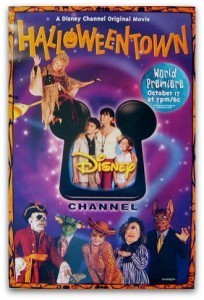 Halloweentown is a made-for-TV movie that aired on the Disney Channel in 1998. The network aired dozens of low-budget, kid-centered movies in the late ‘90s and early 2000s, but this one became a cult classic for Millennials. It’s about a 13-year-old girl named Marnie (Kimberly J. Brown) who loves Halloween but is forbidden from celebrating it by her Halloween-hating mother (Judith Hoag). Marnie finds out why—that she’s a powerful witch—when she secretly follows her grandmother (Debbie Reynolds) onto a magic bus that deposits them in a magical place called Halloweentown. The place is populated by all sorts of magical creatures and Halloween fixtures, including witches, werewolves, skeletons, ogres, vampires, and people with jack-o-lantern heads.
Halloweentown is a made-for-TV movie that aired on the Disney Channel in 1998. The network aired dozens of low-budget, kid-centered movies in the late ‘90s and early 2000s, but this one became a cult classic for Millennials. It’s about a 13-year-old girl named Marnie (Kimberly J. Brown) who loves Halloween but is forbidden from celebrating it by her Halloween-hating mother (Judith Hoag). Marnie finds out why—that she’s a powerful witch—when she secretly follows her grandmother (Debbie Reynolds) onto a magic bus that deposits them in a magical place called Halloweentown. The place is populated by all sorts of magical creatures and Halloween fixtures, including witches, werewolves, skeletons, ogres, vampires, and people with jack-o-lantern heads.
Unlike most Disney Channel movies, this one re-airs most every year and even spawned three sequels. One more claim to fame: Halloweentown is probably the only made-for-TV movie to ever inspire a real-life town’s annual transformation. That’s right: You can visit the “real” Halloweentown!
In 1998, Halloweentown was filmed in St. Helens, Oregon, a small town of 13,000 people with a classic small town look about 30 miles north of Portland, situated on the Columbia River. For the entire month of October, St. Helens turns back into Halloweentown for its “Spirit of Halloweentown” family festival. There are dozens of good-hearted, kid-friendly events that celebrate both the holiday and the town’s brush with made-for-TV history. Spooky carved jack-o-lanterns fill the plaza by city hall (and everywhere else). Bands play songs about monsters. Locals offer tours of movie filming locations. There’s also The Little Spooks Parade, an annual children’s costume parade, a costumed run called the Monster Dash, Haunted Tractor Hay Rides, and a parade where locals dress up their tractors to look like hearses.
St. Helens has such an old-fashioned—and Halloween-y—look that Halloweentown isn’t the only spooky film to film there. Nor is it the most famous one—parts of the vampire blockbuster Twilight were shot there.
The post The Spirit of ‘Halloweentown’ appeared first on .
The First Cancelled TV Show of Each Fall Season
Do you remember these TV programs? Probably not—they were watched by so few people that they were the first new fall show to get the axe in their respective year.
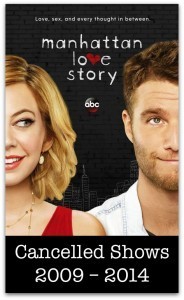 Manhattan Love Story
(2014)
Manhattan Love Story
(2014)
Along with A to Z, Selfie, and others, this was one of several romantic comedies that debuted this year. It was supposed to depict the unfolding of a romance over the course of the TV season. After getting savaged by critics and pulling in just over two million viewers after its fourth episode, ABC pulled the plug, making it the first new fall show to leave the air.
Lucky 7 (2013)
This drama about what happens to seven people who win the lottery didn’t strike it rich—it garnered the lowest ratings for a new fall show in ABC history. It was cancelled after its second episode attracted even less viewers.
Made in Jersey (2012)
This legal drama was about a young lawyer at a New York law firm trying to rise above her blue collar New Jersey background. CBS pulled the show out of production after two episodes had aired.
The Playboy Club (2011)
NBC tried to imitate Mad Men with this show set in a Playboy Club in the early 1960s. It lacked the critical acclaim of Mad Men, however, and The Playboy Club was pulled after three episodes…and protests from the Parents Television Council.
Lone Star (2010)
This quirky soap about a conman living two lives in the Texas oil business was the best reviewed new show of the season. It only made it on the air for two little-watched episodes.
The Beautiful Life (2009)
The CW gave this soap about the hyper-dramatic lives of young models a huge publicity push, with billboards in Time Square picturing the attractive cast near nude. Even on the low-rated CW, The Beautiful Life got some of the networks lowest ratings, with only about a million viewers over two episodes before it was taken off the air.
The post The First Cancelled TV Show of Each Fall Season appeared first on .
October 24, 2014
3 of the World’s Most Spooktacular Bars
Are you looking for a ghoulish watering hole to spend Halloween?
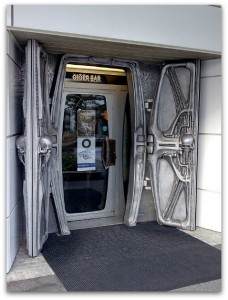 The Giger Bars
The Giger Bars These two Swiss lounges are based on the creepily cool artwork of H.R. Giger, best known as the guy who created the nasty creatures in the Alien films. The H.R. Giger Bar, located in Chur, debuted in 1992. A second one opened for business in Château St. Germain in 2003. Each bar includes furniture and decor with horrifying biomechanical features straight out of the artist’s paintings. There were two more (one in Japan and another in New York City) but they closed down for various reason. But fear not, stateside Giger fans. A hotel operator announced plans in 2014 to open an entire chain of Giger Bars across the U.S.
Dante’s
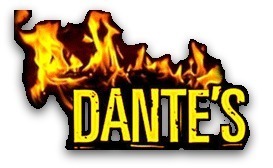 This Portland, Oregon, bar opened in 2000 and it’s still one of the most popular music venues in the city. Partially inspired by Dante’s Inferno, it contains tons of appropriately hellish décor, including a fire pit that was reportedly crafted out of an old Mongolian grill (in a former life, the bar was a Mongolian restaurant). Along with live music, Dante’s hosts a “Sinferno Cabaret” show on Sundays. Its sister bar, The Devil’s Point, can be found on the other side of town and features exotic dances, in addition to a regular karaoke event dubbed “Stripperoke.”
This Portland, Oregon, bar opened in 2000 and it’s still one of the most popular music venues in the city. Partially inspired by Dante’s Inferno, it contains tons of appropriately hellish décor, including a fire pit that was reportedly crafted out of an old Mongolian grill (in a former life, the bar was a Mongolian restaurant). Along with live music, Dante’s hosts a “Sinferno Cabaret” show on Sundays. Its sister bar, The Devil’s Point, can be found on the other side of town and features exotic dances, in addition to a regular karaoke event dubbed “Stripperoke.”
The Vampire Cafe
There are lots of taverns in Japan with crazy themes (“cat cafes” are most common) but this one, located in Tokyo, is devoted entirely to light-fearing immortal bloodsuckers. The walls and floors are all blood red, the dining area has more than a few black velvet curtains, and many of the French-inspired dishes on the menu are served in miniature coffins. Drinks come with plastic skulls and its signature cocktail is named for Dracula. The waiters and waitresses wear plastic fangs and an animatronic vampire pops out of a coffin to greet patrons as they enter. Fang-tastic!
The post 3 of the World’s Most Spooktacular Bars appeared first on .
October 21, 2014
The Year’s Most Interesting State Ballot Measures
Voters in 42 states will vote on a total of 158 statewide ballot measures on Election Day. Here are some of the most interesting state ballot measures we found.
 Alaska
AlaskaTwo major Alaskan industries will face off on Ballot Measure 4. If passed, it would prohibit oil mining in areas in which it would be deemed harmful to wild salmon fisheries.
Arizona
Proposition 303 would allow patients to have access to experimental medical treatments that haven’t been through full clinical trials and that have not yet received FDA approval…provided that they are terminally ill.
Utah
This one sounds a little ominous, if you believe that all politicians are crooks. Amendment C would allow the state’s lieutenant governor, state auditor, and treasurer the right to appoint their own attorneys.
Arkansas
This state has several counties that are “dry,” where alcohol cannot be purchased. If Issue 4 passes, there would be no more dry places—alcohol would be legal to buy, consume, and manufacture statewide.
South Carolina
Amazingly, raffles are illegal in the state, considered a form of gambling. If Amendment 1 passes, raffles would be made legal, but only for charities and non-profit organization.
Missouri
Many countries have week-long or weekend-long voting periods, not just a day. Amendment 6 would create a six-day early voting period.
New York
Do you pay any bills “paperless,” or electronically over the Internet? Proposal 2 would allow legislators to file their bills—meaning laws—electronically, saving lots of paper by not having to print them out for the dozens of other lawmakers.
North Dakota
If Measure 8 passes, it would be illegal for the public school year to begin before Labor Day.
Tennessee
“No new taxes”? Exactly. Amendment 3 would prevent the state legislature from create any new payroll or personal income taxes.
South Dakota
You probably know Deadwood as one of the most notorious Old West towns, filled with gold miners spending their loot on booze, gambling, and prostitutes (as depicted in the 2004-06 HBO series Deadwood.). Voters in South Dakota will vote on Amendment Q, which would once again allow gambling in Deadwood.
The post The Year’s Most Interesting State Ballot Measures appeared first on .
You Probably Think This Book is About You
A look into one of the world’s strangest, and rarely used, literary devices.
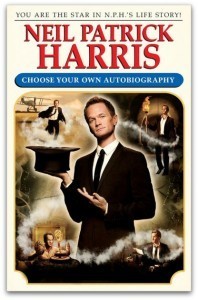 A lot of novels are written in “third person.” This means that the action is told by a narrator who isn’t part of the story, describing the events as they unfold. If the book is “third person omniscient,” it means that the author makes the reader privy to the thoughts of all the characters. Jane Austen wrote this way. If just the main character’s thoughts are given, it’s called “third person subjective.” An example of this: the Harry Potter series.
A lot of novels are written in “third person.” This means that the action is told by a narrator who isn’t part of the story, describing the events as they unfold. If the book is “third person omniscient,” it means that the author makes the reader privy to the thoughts of all the characters. Jane Austen wrote this way. If just the main character’s thoughts are given, it’s called “third person subjective.” An example of this: the Harry Potter series.
First person is another style, generally reserved for memoirs in which the author is telling their life story from their own point of view. It’s also very frequently used in novels—a character in the story is relating their tale as it happens, or as it happened. It can be from the point of view of the main character (like Gulliver’s Travels) or a side character/observer (The Great Gatsby).
“Second person” is a narrative mode that exists but is rarely used, probably because it’s kind of awkward. If first person is in the voice of “I” and third person is in the voice of “they,” second person is in the voice of “you”—the story being told is happening to, from a literary point of view: YOU.
In fact, it’s only been attempted a relative handful of times in Western literature. Jay McInerney’s 1980s tale of New York excess Bright Lights, Big City is the most famous example, which critics hailed as making the narrative feel very alive and vital (after all, it was happening to “you,” as you read).
If you grew up in the 1970s or 1980s, you probably read a Choose Your Own Adventure book. The game-like books, in which the reader made a choice at the end of a passage, affecting what happens next, and allowing for dozens of possible reading experiences, sold millions. Actor and performer Neil Patrick Harris devoured the series as a child, which is why he decided to use the CYOA format for his new memoir, Choose Your Own Autobiography. Most of the book is true, and because it allows for reader choice, some of it isn’t. At any rate, it’s probably the first time an author chose to write a book about “himself” in a way that the reader reads a book about themselves.
The post You Probably Think This Book is About You appeared first on .
October 20, 2014
Ask Uncle John Anything: This One Gets a Thumbs Up!
Uncle John knows pretty much everything—and if he doesn’t, he heads his massive research library, or puts one of his many associates on the case. So go ahead: In the comments below, ask Uncle John anything. (And if we answer your question sometime, we’ll send you a free book!)
What’s the origin of the “thumbs up” gesture?
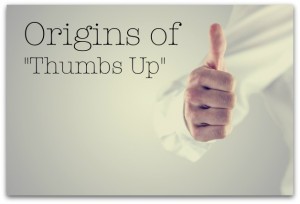 In the days of gladiator battles in ancient Rome, the losing gladiator would be then put to death…unless the emperor in attendance saved him by holding out a fist with his thumb extended upward. (A down-pointing thumb meant the death penalty stood.)
In the days of gladiator battles in ancient Rome, the losing gladiator would be then put to death…unless the emperor in attendance saved him by holding out a fist with his thumb extended upward. (A down-pointing thumb meant the death penalty stood.)
You may have heard this story, and been told it’s the origin of the common “thumbs up” and “thumbs down” gestures. But it’s not true. Roman emperors never did that—the gladiator was almost always sentenced to death anyway. The idea that the gestures came frome Rome dates to the popular 1872 painting Pollice Verso by French painter Jean-Leon Germome. It depicts a gladiator receiving a thumbs-down from an emperor in his luxury box at the battles. The thumbs down was taken from this, and the meaning of thumbs up was extrapolated.
There are two far more likely origins fur the gesture. In medieval Europe, businessman would make the gesture at each other to approve a deal or a sale, the era’s equivalent of an oral agreement of “handshake deal.” In World II, the Flying Tiger brigade of American pilots was based in China. Supportive locals showed their thanks to the pilots by giving them a thumbs up, which is a Chinese gesture that means literally “number one” and figuratively “nice job.” Pilots throughout the U.S. and allied military adopted it, where it became a “ready to go” visual gesture to ground crew that they were ready for takeoff from aircraft carriers.
However, this does not mean “I approve!” or “hello, friend!” or “Siskel and I liked this movie” in the Middle East, West Africa, or South America. In these places, the thumbs up is an offensive gesture that means, roughly, “up yours.”
The post Ask Uncle John Anything: This One Gets a Thumbs Up! appeared first on .
Vote Vader!
 The midterm elections are about to go down in the U.S., but in Ukraine, voters are trying to decide if they should cast their votes for a certain Sith lord.
The midterm elections are about to go down in the U.S., but in Ukraine, voters are trying to decide if they should cast their votes for a certain Sith lord.
The eastern European nation has seen more than its fair share of turbulence this year, fueling Ukrainian Internet Party to satirize the country’s parliamentary elections. They’ve selected not just one but multiple Darth Vaders as their picks for various seats.
The party also created a series of campaign advertisements for all their Vaders. They feature the former Anakin Skywalker romping around the countryside. In one ad, he strums the “Imperial March” on a traditional Ukrainian musical instrument. In another, he takes a black horse for a walk before sticking his lightsaber in the ground and removing his helmet.
That’s probably a reference to the Vaders’ statuses as dark horse candidates. Indeed, they’ll be facing some tough (and equally interstellar) competition when Ukrainian voters head to the polls on October 26th. For example, other nominees from Odessa, Ukraine’s third-largest city, include Stepan “Chewbacca” Chubakka, Master V. Yoda, and Padme N. Amidala.
In addition to the seven Vaders selected by the UIP, at least five more candidates around the country have filed as “Darth Vader” (they’re all running as independents). This also isn’t the first time the Sith lord has run amok in the world of Ukrainian politics. Last year, activists in Vader costumes tried to enter the country’s Justice Ministry to pester a politician named Oleksandr Lavrynovych.
Back in 2011, a Ukrainian official had a Vader walk into his office to demand a free plot of land. He cited a law stating that citizens have a right to be granted up to 1,000 square meters of property in certain circumstances. What sort of circumstances? After informing the official that he was Darth Vader, the man said that, because local politicians had “switched to the Dark Side,” he deserved some complimentary real estate where he could park his “space cruiser.”
The post Vote Vader! appeared first on .
October 17, 2014
The Very Tiny Bugs That Live on Your Face
If you’re squeamish, you might want to skip this one…but those little creatures are still going to be on your face.
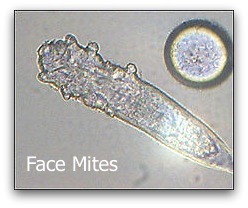 As you read this, there are likely tiny, eight-legged mites called demodex going about their daily business on your face. Scientists have identified 65 different species of them in all, of which two—Demodex folliculorum and Demodex brevis—hang out on humans. They especially like hair follicles and are commonly found where hair grows on or near the face. Have you got a beard? There’s probably quite a few mites in there. What about nose hair, eyebrows, and eyelashes? Ditto.
As you read this, there are likely tiny, eight-legged mites called demodex going about their daily business on your face. Scientists have identified 65 different species of them in all, of which two—Demodex folliculorum and Demodex brevis—hang out on humans. They especially like hair follicles and are commonly found where hair grows on or near the face. Have you got a beard? There’s probably quite a few mites in there. What about nose hair, eyebrows, and eyelashes? Ditto.
The semi-transparent and relatively harmless creatures, which are also sometimes referred to as eyelash mites, are very small, which is why you don’t spend much of your day trying to squish them with Kleenex. The average male is only about 0.4 millimeters long. Instead of catching bugs like spiders, the mites prefer to dine on skin cells and facial oils. They prefer the face because it has the oiliest areas on the human body. They also like to lay their eggs in hair follicles or glands, which hatch after three or four days. The average lifespan of one of these little guys is just a few weeks. Around 33 percent of children carry these mites. It jumps to 50 percent for adults, and two-thirds for the elderly.
Here’s where things really start getting a bit freaky. Some scientists theorize that the mites could be the root cause of rosacea, the condition that causes many fair skinned people to appear like they’re permanently blushing. A 2012 review conducted by the National University of Ireland contends that bacteria that reside in the bugs can trigger the condition. Others think that the mites could be the culprits responsible for a few other skin disorders.
The post The Very Tiny Bugs That Live on Your Face appeared first on .
October 14, 2014
3 Baseball Records That Probably Won’t Be Broken Anytime Soon
Some achievements on the field might stand forever…simply because the game just isn’t played the same way anymore.
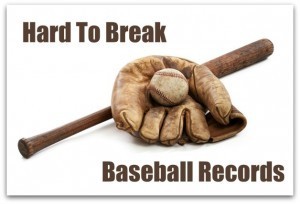 Walter Johnson’s 110 career shutouts
Walter Johnson’s 110 career shutoutsJohnson pitched for the Washington Senators from 1907 to 1927. While playing for one team for an entire career in today’s era of free agency is rare enough (recent exception: forever-Yankee Derek Jeter), Johnson routinely pitched complete games. To save players’ arms, and maximize their efficiency, teams today generally use two or three pitchers over the course of a game. Pitchers rarely throw for an entire game, let alone not allow any runs the whole time. The active player closest to Johnson’s shutout record is Tim Hudson…with 13.
Cy Young’s 511 wins
The only pitcher to win more games than Johnson (417) was Young, a pitcher so dominant in early baseball that the award for the season’s best pitchers is named after him. Again, his record will likely stand forever because teams work their pitchers less. Today, a starting pitcher is part of a five-man rotation. In the late 19th and early 20th centuries, it was a three-man rotation, allowing for more games played and opportunities to win. Again, the closest pitcher today, to Young, is Tim Hudson, with 214 games won.
Bob Gibson’s 1.12 earned run average
Bob Gibson so thoroughly destroyed the competition in 1968 that the rules of Major League Baseball were changed. The St. Louis Cardinals ace threw 13 shutouts and threw all nine innings of all 34 games he started. His earned run average, a measure by which pitchers are judged, of which the closer to 0 it is, the better, was a record 1.12. Only two pitchers—Dwight Gooden and Pedro Martinez—have gotten under 2.00 in the decades since. After the season MLB passed the “Gibson rules,” lowering the pitcher’s mound by five inches and shrinking the strike zone to give opposing batters a better shot.
The post 3 Baseball Records That Probably Won’t Be Broken Anytime Soon appeared first on .



